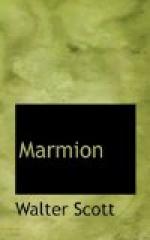line 10. ’Lindisfarne, an isle on the coast of Northumberland, was called Holy Island, from the sanctity of its ancient monastery, and from its having been the episcopal seat of the see of Durham during the early ages of British Christianity. A succession of holy men held that office: but their merits were swallowed up in the superior fame of St. Cuthbert, who was sixth bishop of Durham, and who bestowed the name of his “patrimony” upon the extensive property of the see. The ruins of the monastery upon Holy Island betoken great antiquity. The arches are, in general, strictly Saxon, and the pillars which support them, short, strong, and massy. In some places, however, there are pointed windows, which indicate that the building has been repaired at a period long subsequent to the original foundation. The exterior ornaments of the building, being of a light sandy stone, have been wasted, as described in the text. Lindisfarne is not properly an island, but rather, as the Venerable Bede has termed it, a semi-isle; for, although surrounded by the sea at full tide, the ebb leaves the sands dry between it and the opposite coast of Northumberland, from which it is about three miles distant.’—Scott.
The monastery, of which the present ruins remain, was built, between 1093 and 1120, by Benedictine monks under the direction of William Carileph, Bishop of Durham. There were sixteen bishops in Holy Island between St. Aidan (635 A. D.) and Eardulph (875 A. D.). The Christians were dispersed after the violent inroad of the Danes in 868, and for two centuries Lindisfarne suffered apparent relapse. Lindisfarne (Gael. farne, a retreat) signifies ’a place of retreat by the brook Lindis.’ The name Holy Island was given by Carileph’s monks, to commemorate, they said, ’the sacred blood which had been shed by the Danes.’ See Raine’s ‘History of North Durham,’ F. R. Wilson’s ‘Churches of Lindisfarne,’ and Mr. Keeling’s ’Lindisfarne, or Holy Island: its History and Associations.’
line 17. Cp. Coleridge’s ’Ancient Mariner’:—
’The fair breeze
blew, the white foam flew,
The farrow followed
free.’
line 20. For Saint Hilda, see below, note on line 244.
Stanza ii. line 33. sea-dog, the seal.
line 36. still. Cp. above, I. 430.
line 44. A Novice is one under probation for a term extending to at least a year, and it may extend to two or three years, after which vows are either taken or declined.
Stanza iv. line 70. Benedictine school. St. Benedict founded his order—sometimes, because of their dark garb, called Black Friars— in the beginning of the sixth century. Benedict of Aniana, in the eighth century, reformed the discipline of the order.
line 74. Cp. Chaucer’s Prioress in the Prologue:—
’And sikerly sche was of
gret disport,
And ful plesaunt, and amyable of port.’
Stanza V. line 90. Cp. Spenser’s Una, ‘Faery Queene,’ I. iv:—




